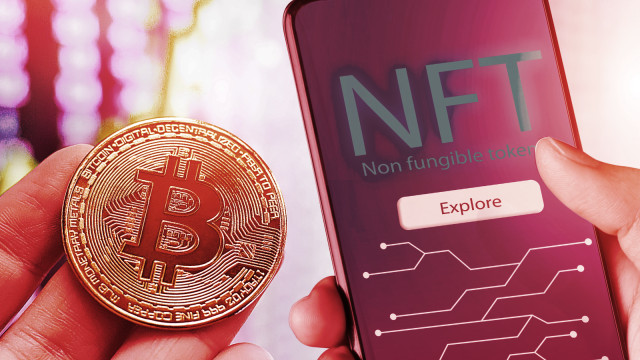Bitcoin NFTs are non-fungible tokens that are powered by the Bitcoin blockchain.
These NFTs have taken the entire crypto space by storm within a short time. Bitcoin nonfungible tokens have captured the crypto world’s attention quickly, opening some new opportunities for the oldest blockchain and digital art enthusiasts. Since exploding in 2020, NFTs have been normally minted and traded on Ethereum-based platforms, and other blockchains like Solana and Cardano.
But, a new protocol called Ordinals was introduced in January 2023 by Casey Rodarmor, a former Bitcoin Core contributor, who exploited the 2021 Bitcoin Taproot upgrade to expand the crypto capability and support on-chain Bitcoin-native NFTs.

Taproot provided a way to significantly expand the base layer’s block capability by condensing the size of transactions needing less data consumption and encouraging the utilization of smart contracts on Bitcoin. This upgrade increased the kinds of transactions possible on Bitcoin, including NFT and decentralized finance (DeFi) applications.
By February 2023, the world’s biggest issuer of nonfungible tokens, Yuga Labs, had already confirmed the development of TwelveFold, a new NFT collection issued on Bitcoin, hence endorsing Bitcoin NFTs and vouching for their success.
Here is what to know about Bitcoin NFTs, and how they are different from the Ethereum-based alternatives.
What Are Ordinals?
Ordinals are serial numbers that are imprinted in a single, distinct satoshi (sat), the smallest unit of Bitcoin (BTC), via the ordinal theory that mainly assigns them in the order in which they get mined. The first satoshi in the first block has the ordinal number 0, the second has the ordinal number 1, and the last satoshi of the first block has the ordinal number 4,999,999,999.
The colored coins were the first representation of such a concept back in 2012, being crypto assets that are repurposed to represent something of value by adding metadata information. Counterparty is another attempt to embed data into normal Bitcoin transactions. Nevertheless, it has its XCP token, needed for some functionality, making it officially like an altcoin and not an extension or second layer for Bitcoin.
The ordinal theory rewards satoshis with numismatic value, enabling them to get collected and traded as rarities. Satoshis are given unique identities to get tracked, transferred, and ingrained with significant arbitrary data, including pictures, videos, or texts, via a Bitcoin transaction that remains permanently a part of the blockchain.
This data can be viewed in Ordinals-compatible wallets, such as the Sparrow wallet, and online explorers.
Inscriptions
The process of assigning assets to unique satoshis is known as an inscription. Inscriptions are digital artifacts native to the Bitcoin blockchain, the digital equivalent of physical artifacts.
They are wholly on-chain, do not need a sidechain or a separate token, and use the Ordinals protocol to inscribe sats with content on ord, an explorer, an index, and a wallet that relies on Bitcoin Core for private key management and signing of transactions.
Ord supports the tracking of the location of specific satoshis and their ordinal numbers and can be viewed with the Ordinals explorer. Contrary to the traditional NFTs that heavily rely on off-chain content that is stored on the interplanetary file system (IPFS), inscriptions are integrated with Bitcoin’s immutability and security. They are uncensorable and permissionless digital artifacts since they can get sold without a royalty.
How To Create Bitcoin NFTs
The Ordinals ecosystem is in active development, but its accessibility is quite restricted to only two main ways to mint an ordinal NFT.
The first strategy to inscribe Bitcoin Ordinals needs some technical skills, running a full Bitcoin node and then installing Ord on this node to inscribe satoshis into an Ordinals wallet and make Bitcoin Ordinals NFTs.
Two kinds of Bitcoin wallets can process Ordinals; they must be Taproot-compatible and have a ‘coin control’ capability to avoid spending Ordinal satoshis as network fees or sending them accidentally in another unrelated transaction.
- The Sparrow wallet is just recommended for receiving Ordinals to avoid cases of sending Ordinals sats mistakably. Nevertheless, using it does not need running an entire node. Here you can learn how to set up a Sparrow wallet.
- An Ord wallet needs running an entire node on 500GB capacity. As opposed to the Sparrow wallet, an Ord wallet lets you create inscriptions and freeze the inscribed sats to avoid cases of accidental spending. Here is a guide on how to set up an Ord wallet.
Irrespective of the wallet that you are using, ensure that you have some Bitcoin available to pay for the transaction fee. The second strategy is easier and involves the use of a no-code tool, like Gamma or Ordinalsbot.com, to inscribe your ordinal NFT.

Controversy
The new Ordinals protocol has raised important issues and sparked a heated debate among the NFT community. Should Bitcoin only be money, or does it need to expand its functionality to the other use cases available? Is the Ordinals protocol an attack on the Bitcoin network?
The Bitcoin blockchain has always been used just for payments because of its limited block size and network architecture. Such a network favors solutions designed on top of the blockchain as extra layers to enhance the network’s programmability and scalability.
The latest Ordinals craze has already raised many eyebrows among the BTC community. Some are worried it might distract from Bitcoin’s main use case as a medium of exchange and whether Ordinals make great use of block space. Ordinals can be audio clips, images, or even games inevitably needing space that is eliminated from the financial data, considerably slowing down on-chain confirmation times.
